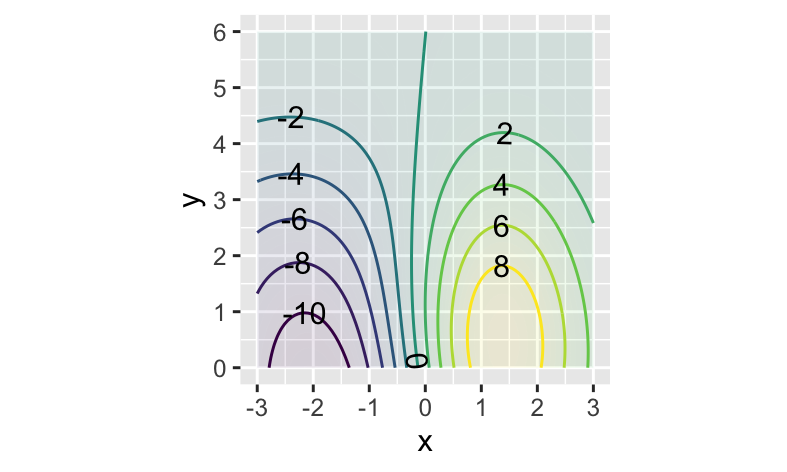question id: drill-partialderivatives-1
Chap 24 Review
\[ \newcommand{\dnorm}{\text{dnorm}} \newcommand{\pnorm}{\text{pnorm}} \newcommand{\recip}{\text{recip}} \]
Exercise 1 What is \(\partial_x x\)?
Exercise 2 What is \(\partial_x y\)?
question id: drill-partialderivatives-2
Exercise 3 What is \(\partial_x a\, x\)?
question id: drill-partialderivatives-3
Exercise 4 What is \(\partial_x x\, y\)?
question id: drill-partialderivatives-4
Exercise 5 What is \(\partial_y x\, y\)?
question id: drill-partialderivatives-5
Exercise 6 What is \(\partial_x A e^{kt}\)?
question id: drill-partialderivatives-6
Exercise 7 What is \(\partial_t A e^{kt}\)?
question id: drill-partialderivatives-7
Exercise 8 What is \(\partial_x A x e^{kt}\)?
question id: drill-partialderivatives-8
Exercise 9 What is \(\partial_t A x e^{kt}\)?
question id: drill-partialderivatives-9
Exercise 10 What is \(\partial_x \left[\strut a_0 + a_1 x + a_2 x^2 \right]\)?
question id: drill-partialderivatives-10
Exercise 11 What is \(\partial_y \left[\strut a_0 + a_1 x + a_2 x^2 \right]\)?
question id: drill-partialderivatives-11
Exercise 12 What is \(\partial_x \left[\strut a_0 + a_1 y + a_2 y^2 \right]\)?
question id: drill-partialderivatives-12
Exercise 13 What is \(\partial_x \left[\strut a_0 + a_1 x + b_1 y + c x y \right]\)?
question id: drill-partialderivatives-13
Exercise 14 What is \(\partial_y \left[\strut a_0 + a_1 x + b_1 y + c x y \right]\)?
question id: drill-partialderivatives-14
Exercise 15 What is \(\partial_x \partial_y \left[\strut a_0 + a_1 x + b_1 y + c x y \right]\)? (Usually we would write \(\partial_{xy}\) instead of \(\partial_x \partial_y\), but they amount to the same thing.)
question id: drill-partialderivatives-15
Exercise 16 What is \(\partial_x \partial_x \left[\strut a_0 + a_1 x + b_1 y + c x y \right]\)? (Usually we would write \(\partial_{xx}\) instead of \(\partial_x \partial_x\), but they amount to the same thing.)
question id: drill-partialderivatives-16
Exercise 17 What is \(\partial_x \partial_x \left[\strut a_0 + a_1 x + b_1 y + c x y + a_2 x^2 + b_2 y^2 \right]\)? (Usually we would write \(\partial_{xx}\) instead of \(\partial_x \partial_x\), but they amount to the same thing.)
question id: drill-partialderivatives-17
Exercise 18 What is \(\partial_y \partial_x \left[\strut a_0 + a_1 x + b_1 y + c x y + a_2 x^2 + b_2 y^2 \right]\)? (Usually we would write \(\partial_{yx}\) instead of \(\partial_y \partial_x\), but they amount to the same thing.)
question id: drill-partialderivatives-18
Exercise 19 What is \(\partial_x \left[\strut A x^n y^m \right]\)?
question id: drill-partialderivatives-19
Exercise 20 What is \(\partial_y \left[\strut A x^n y^m \right]\)?
question id: drill-partialderivatives-20
Exercise 21 What is \(\partial_{xy} \left[\strut A x^n y^m \right]\)?
question id: drill-partialderivatives-21
Exercise 22 What is \(\partial_x \left[\strut f(x) + y\right]\)?
question id: drill-partialderivatives-22
Exercise 23 What is \(\partial_x \left[\strut f(x) + g(y)\right]\)?
question id: drill-partialderivatives-23
Exercise 24 What is \(\partial_y \left[\strut f(x) + g(y)\right]\)?
question id: drill-partialderivatives-24
Exercise 25 What is \(\partial_x \partial_y \left[\strut f(x) + g(y)\right]\)?
question id: drill-partialderivatives-25
Exercise 26 What is \(\partial_y \partial_y \left[\strut f(x) + g(y)\right]\)?
question id: drill-partialderivatives-26
Exercise 27 What is \(\partial_y f(x) g(y)\)?
\(\partial_y g(y)\)
\(f(x)\ \partial_{y} g(y)\)
0
\(g(y)\ \partial_y f(x) + f(x) \ \partial_y g(y)\)
question id: drill-partialderivatives-27
Exercise 28 What is \(\partial_y h(x,y) g(y)\)?
question id: drill-partialderivatives-28
Exercise 29 What is \(\partial_x h(x,y) g(y)\)?
question id: drill-partialderivatives-29
Exercise 30 What is \(\partial_{yx} h(x,y) g(y)\)?
\(\partial_{yx} h(x, y)\)
\(g(y) \partial_{yx} h(x,y) + h(x,y)\ \partial_y g(y)\)
\((\partial_y g(y)) \ (\partial_x h(x, y)) + g(y)\ (\partial_{yx} h(x, y))\)
\((\partial_x g(y))\ (\partial_x h(x, y)) + g(y) (\partial_{xx} h(x, y) )\)
question id: drill-partialderivatives-30
Exercise 31 What is the “with-respect-to” input in \(\partial_y xy\)?
question id: drill-partialderivatives-31
Exercise 32 What is the “with-respect-to” input in \(\partial_x y\)?
question id: drill-partialderivatives-32
Exercise 33 What is the “with-respect-to” input in \(\partial_t y\)?
question id: drill-partialderivatives-33
Exercise 34 
At which of these inputs is the function steepest in the x-direction?
question id: drill-Quiz-2-16
Exercise 35 
At which of these inputs is the function practically flat?
question id: drill-Quiz-2-18
Exercise 36 
You are standing on the input point \((x=-1,y=4)\). In terms of the compass points (where north would be up and east to the right), which direction points most steeply uphill from where you are standing.
question id: drill-Quiz-2-19
Exercise 37 
You are standing on the input point \((x=2,y=1)\). In terms of the compass points (where north would be up and east to the right), which direction points most steeply uphill from where you are standing.
question id: drill-Quiz-2-20